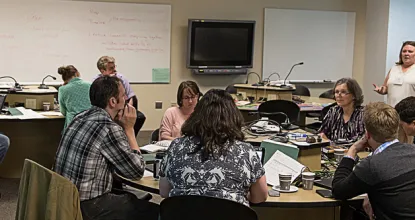Historically, learning circles have been used by many groups to bring together individuals interested in exploring ideas in a respectful learning environment. References to circles can be found in many disciplines including Native American studies, education, and counseling. Although the use of circles can be found in many settings and cultures, we acknowledge the influence of local Native American cultural customs, like the talking circle tradition of the Anishinaabe.
Here at NMU, Learning Circles are designed as an informal mechanism to draw together faculty and other instructional staff who have an interest in a particular topic related to higher education to build knowledge and support professional development. The idea is to gather people interested in the same topic together, especially if they come from different areas or disciplines. This is a great way to spend a modest amount of time learning about education with a group of colleagues!
Overview
Learning Circles will be organized by a facilitator drawn from the campus community, with support from the Center for Teaching & Learning (CTL). Each circle will be advertised through the CTL. They typically have 3-8 meetings at which members work together to learn about a particular content area. These meetings may occur very close together so that the entire Circle might be completed in a weekend or they could be spaced out over 1-2 months. Learning Circles are not encouraged to continue longer than two months; they are intended to be short-term commitments by their members who want to collaboratively learn about a particular content area related to university teaching without an excessive time commitment.
Topics
Topics for Learning Circles can be anything related to university-level teaching. Topic areas may range from teaching itself (Dealing with Large Classes, Addressing Plagiarism, etc.), to broad trends in teaching (MOOCS, Diversity in the Classroom, Course Assessment, etc.) to related areas (Instructor Peer Evaluation, data collection for educational research, etc.). They might be centered on a new book on education or other resource such as a webinar or conference as well.
Circle Members
While there is a facilitator for each circle, this person is more a liaison to the CTL than a leader of the group with any special knowledge. Circles are intended to be completely egalitarian and all members play an equal role in their success. Members decide as a group on the specific format of the circle in order to best meet the learning needs of the group. It is at the discretion of the facilitator if membership should be limited in any way (e.g. faculty only, new faculty only), otherwise they may be open to any interested party including department heads, administrators, graduate students, or staff.
Getting Started
NMU faculty and staff interested in facilitating a Learning Circle can submit a proposal with their idea to the CTL. The CTL team will review submissions and discuss them with potential facilitators.
Requirements for Circles
Each circle must be comprised of 5-12 individuals. Fewer than five people will not be enough to constitute a circle and we can try to topic again at another time. More than 12 can inhibit interactions. However, if more than 12 people are interested, we may be able to offer a second concurrent Learning Circle on the same topic, provided that there is someone willing to facilitate the second group.
Members are expected to attend and fully participate in the sessions. A Circle will agree to generate a simple product which will be available via the CTL webpage. Products need not be extensive and will be appropriate to the topic proposed; examples include a group book review, a document listing best practices gleaned from the literature, a review summary of the group’s research on a topic, or just a brief summary group's discussions.
When will these happen?
We are happy to start Learning Circles at varying times, although the CTL will likely actively solicit new topics once each semester. If you have an idea, let us know and we can help you get started!!
